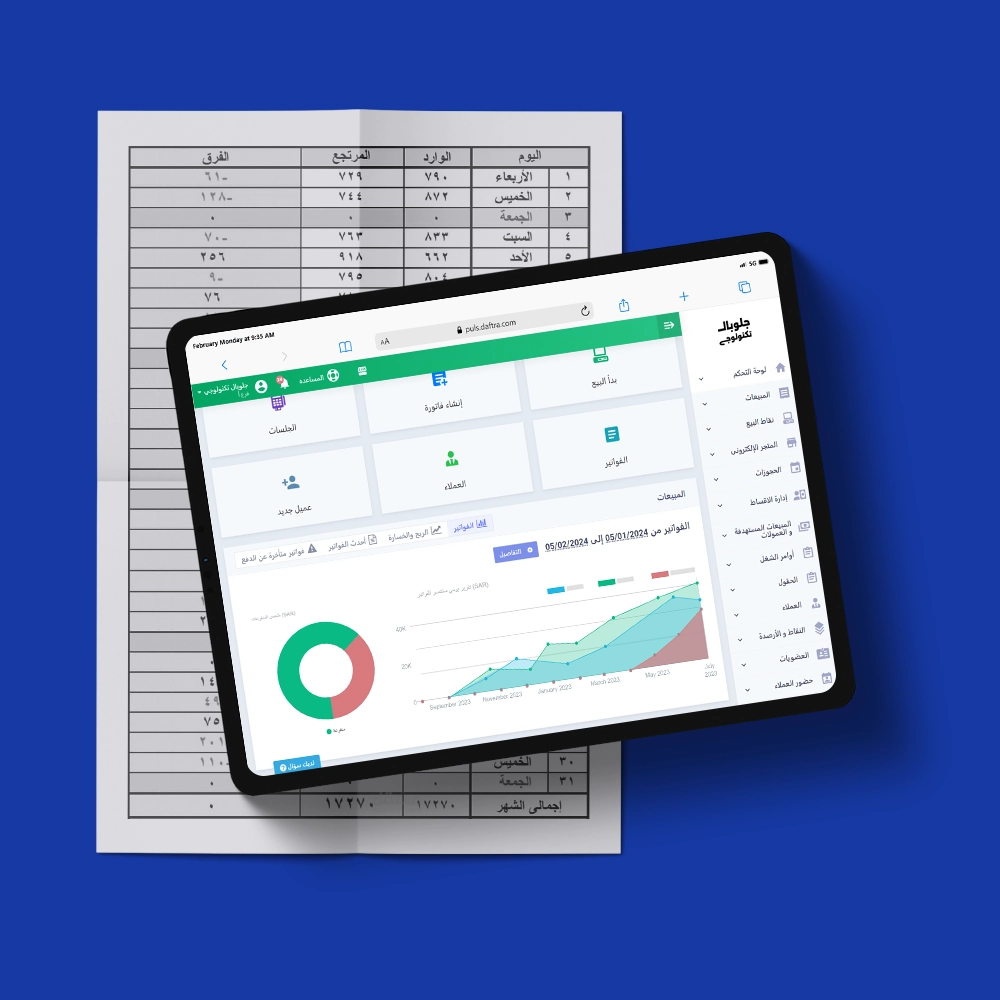Creative Accounting Guide and Its Objectives

Table of contents:
- Quick Points (Useful Summary)
- What is Creative Accounting and How Does It Work?
- When Did Creative Accounting Emerge?
- What are the Reasons for the Emergence of Creative Accounting?
- What are the Objectives of Creative Accounting?
- What is the Importance of Creative Accounting?
- What are the Methods and Techniques of Creative Accounting?
- What is the Impact of Creative Accounting on Financial Statements?
- What are the Other Effects of Creative Accounting Besides Financial Statements?
- Is Creative Accounting Legal?
- What are the Methods Used to Limit the Effects of Creative Accounting?
- What is the Role of the Auditor in Verifying Creative Accounting Practices and Results?
- What distinguishes Daftra as an Accounting software?
- Frequently Asked Questions
The types of accounting have diversified between financial accounting, cost accounting, tax accounting, administrative accounting, and governmental accounting. But has the term "creative accounting" ever crossed your mind as one of the branches of accounting science? Or have you ever doubted the accuracy of information that accountants publish in companies' financial statements?
Most likely, your answer will be no, but perhaps you will be surprised to learn about an uncommon term in accounting science based on illegitimate accounting practices called creative accounting.
Perhaps the word "creative" deceives you at first glance and makes you think it refers to excellence and diligence in work, but the opposite is true - creative accounting is considered a model of evasion, manipulation, and outright deception.
Quick Points (Useful Summary)
- Creative accounting is a set of accounting procedures and activities that exploit legal loopholes to improve a company's image.
- Cloud accounting began in the 1960s of the last century and was associated with companies that went bankrupt after manipulating profits and being unable to pay debts.
- Creative accounting is legal, and its implementer is not subject to legal accountability except when it affects public opinion and misleads investors with information that leads to wrong decisions.
- Regardless of the type of audit the auditor performs, whether partial, complete, continuous, or other, the auditor is responsible for reviewing items and accounts related to any activity that falls under creative accounting. They review sales, cost of goods sold, operating expenses, cash, and accounts receivable.
- There are several forms of creative accounting, including inflating expected revenues above actual, reducing asset depreciation costs through capitalization, increasing deferred costs, hiding liabilities, and manipulating inventory.
What is Creative Accounting and How Does It Work?
Creative accounting is the manipulation of actual numbers found in the company's financial statements and reports. This is done by accountants within the company either to achieve personal interests or by management's orders, with the aim of obtaining fictitious profits or unrealistic achievements and a false financial position.
Accounting data manipulation is carried out by exploiting some gaps in accounting principles and standards. This manipulation primarily aims to beautify the company's image and maximize its profitability results and financial position in a way that is completely far from reality to achieve the goals they seek, and to mislead investors and external parties about the company's position.
Companies that practice this type of fraud become a fertile environment for growing everything that is illegal, including cheating, theft, and deception. Therefore, companies eventually fall victim to the disadvantages of their actions, and their fate becomes failure.
An experienced accountant who possesses sufficient experience uses some accounting laws and principles, distorts them, and searches for their gaps in order to carry out several manipulations, such as changing profit figures in financial statements either by increasing or decreasing, and manipulating revenues and expenses to achieve special purposes.
In summary, creative accounting is the alteration and manipulation of data for the company's private interests, and this is considered a simplified answer about what creative accounting practices are.
When Did Creative Accounting Emerge?
Creative accounting practices emerged in the 1960s of the twentieth century after the collapse of mortgage companies. The term first appeared in Anglo-Saxon literature at the beginning of the seventies, referring to companies that went bankrupt despite achieving profits due to their inability to pay debts, and from here, creative accounting emerged.
What are the Reasons for the Emergence of Creative Accounting?
Creative accounting began to emerge during the recession of the eighties, when companies found difficulties in operating and achieving profits.
Companies that were on the verge of collapse resorted to fabricating these profits and falsifying their published financial reports to attract investments and achieve actual profits through this means. The motives of these companies for resorting to creative accounting have been numerous.
The primary motivation is the conflict between different interests within and outside the company. For example, we find that all parties seek to achieve their personal interests, ranging from managers and employees within the company to shareholders and investors, and even those who aim to evade tax burdens without violating tax accounting laws. Certainly, the abundance and multiplicity of interests created differences and conflict.
Also among the recognized motives for the emergence of creative accounting is providing companies with the opportunity to choose from several elements, such as freedom of choice in estimation and freedom of disclosure according to accounting standards.
What are the Objectives of Creative Accounting?
Creative accounting has strong objectives for companies. Simply put, we will mention what creative accounting aims for, and in summary, it aims to help companies with tax evasion, improve the company's reputation, and is a fundamental tool in achieving the company's interests, as it also helps in raising stock prices.
After we have learned about creative accounting briefly, here are the detailed objectives of creative accounting in greater depth:
1- Tax Evasion
The company targets using creative accounting to carry out several manipulations, where profit ratios are reduced and company expenses are increased, thus reducing the taxes shown in the tax return as taxes imposed on the company. Company management relies on external accountants for this purpose.
2- Improving Company Reputation to Obtain Necessary Financing
For an investor to feel confident about the company, they need evidence proving the company's success and current financial position to ensure that their financing is guaranteed and will return to them with profits in the end.
When companies need financing to ensure business continuity during liquidity crises, they resort to using creative accounting to mislead and deceive financiers, giving them a false picture of the company's financial position to obtain financing.
3- Achieving Personal Interests
The main reason for the 2008 financial crisis was company managers' pursuit of personal interests and self-gain through the use of creative accounting.
These interests aim to improve the image of company management before the board of directors without regard for any other rights, whether for the rest of the company's members or for society.
4- Raising Stock Prices
Creative accounting is used with the aim of influencing the values of company shares traded in financial markets.
5- Competition and Professional Classification
Creative accounting is used to outperform competitors in the same field, where international institutions review companies' financial statements in order to conduct professional classification.
From here, companies resort to manipulating income statement elements to falsify their financial profits to obtain a good classification and then dominate and control the market.
What is the Importance of Creative Accounting?
People don't create anything in vain. Everything they create has goals and intentions that are important to them. Although this accounting performance that stems from the application of creative accounting is immoral and not welcomed by many, why is creative accounting important to some? It helps attract investors from everywhere, maintain the company's position, and also create a good impression of the company. Here is the importance of creative accounting in detail:
1- Attracting Investors
Users of creative accounting aim to announce regular and high profits for the company, and prove this through announced data and statements, in addition to giving a dose of optimism by guaranteeing a profitable future, and hiding any setbacks or potential risks.
2- Maintaining Company Standards
There are certain requirements that are almost imposed on companies for the company's name to continue in the market and for investors to continue dealing with it. Company accounting, when distributing profits according to partners' shares in a fair manner, cannot meet what is required for continuation; so the company is unable to rotate its operations, and to maintain these conditions and continue, it resorts to using creative accounting.
3- Good Impression for Company Name and Reputation
The company's reputation in the market can be improved through publishing misleading reports that indicate achieving certain goals and hiding reality.
Through this impact on the company and its owners, and obtaining a distinguished position in the market and a bright image thanks to creative accounting, the answer to the question of what the motives are for using creative accounting becomes easier, as it is a strong foundation for companies to obtain the financing they desire and gain investors and special appeal in the market.
What are the Methods and Techniques of Creative Accounting?
The Financial Studies and Research Center in the United States revealed the methods and techniques used by creative accounting users to commit fraud and manipulate the published financial data of companies. These methods and approaches can be summarized as:
1- Manipulating Company Expenses
Adapting cost accounts in a false manner that serves specific purposes.
2- Manipulating Revenues
Among the methods and approaches of creative accounting is changing revenues and estimating them in an exaggerated manner that differs from reality.
3- Manipulating Accounts Receivable
This is maliciously manipulating the company's financial receivables to achieve specific interests.
4- Manipulating Income Items
Through creative accounting, income items and financing items specific to the company are manipulated.
5- Manipulating Accounting Standards and Policies
Through creative accounting, accounting standards can be manipulated and changed to suit the company's desire and interest.
6- Manipulating Company Assets and Receivables
Among the methods of creative accounting is manipulating the company's assets, such as inflating them or making them higher in value, or recording assets that do not exist in the first place, for the company to obtain a different status.
7- Directing Company Management to Manipulate Financial Statement Figures
Creative accounting directs company management to manipulate finances in a way that serves management and gives a good impression of its performance.
8- Manipulating Profits
Through announcing profits due in the future during periods when there are no satisfactory profit ratios, with the aim of improving the image of management and the company.
9- Company Delaying Announcement of Its Profits
The company delays announcing its profits for this year, which allows it to evade taxes officially.
10- Exaggerating or Underestimating the Valuation of Money in Foreign Currencies
Companies do this through creative accounting, which in turn affects the increase or decrease in profit ratios.
11- Wrong Evaluation of Investment Returns
Through considering investment returns as company profits in order to increase operational profits.
Use the investment calculator to know the value of return on investment.
12- Using Accounting Software with Loopholes
Using electronic accounting software that contains many loopholes to allow their exploitation to achieve creative accounting objectives.
Creative accounting methods can be summarized as manipulating company expenses, revenues, financial statements, income items, and all details related to the company to reach the company's interest, increase its profit, and raise its status.
What is the Impact of Creative Accounting on Financial Statements?
There is a question that revolves in many people's minds: "What are the effects of creative accounting on financial statements?" Creative accounting has effects on various branches of financial statements, such as the income statement, balance sheet, statement of changes in equity, and finally the cash flow statement. Here is the impact of creative accounting on financial statements in detail:
1- Impact of Creative Accounting on Income Statement
Companies seek to adjust profits in a way that suits their specific objectives by manipulating several elements, for example:
- Recording sales early: Before the specified period for completing the transaction ends, i.e., before it officially occurs, or recording fake revenues for sales operations that are still uncertain, or even fictitious sales at the end of the period and writing them off immediately at the beginning of the following accounting period, with the aim of increasing announced and bookkeeping-recorded sales revenues and thus increasing profits.
- Switching accounting methods: Switching the methods applied in work to other methods, such as inventory valuation methods and fixed asset methods.
- Delaying recording of purchases: Not recording purchases in the same accounting period in which the purchase operation took place, and postponing them to the next period, so that the company can reduce the cost of goods when selling them with the aim of increasing profits.
- Delaying recording of revenues: Not recording revenues for the current period if high profits are achieved, and postponing the recording to a period when lower profit ratios are expected to occur. This is a manipulation to control profit ratios and keep them at a close level despite accounting standards requiring recording revenues in the period in which they occurred.
2- Impact of Creative Accounting on Balance Sheet
Creative accounting significantly affects the balance sheet through several things:
- Improving profits and cash liquidity: Through manipulating debts, where bad debts are considered among debts expected to be collected, in addition to reducing the ratios of debts that may not be collected, thus maximizing debtors' items.
- Manipulating investments: Through recording short-term investments as long-term investments with the aim of protecting from sudden price drops, which ultimately leads to increasing profit ratios.
- Not using fixed asset depreciation rates: Not using depreciation rates applied in the market and replacing them with lower rates, and maximizing the value of depreciated assets, in addition to not excluding worthless assets that have no value.
- Recording assets likely to be collected without confirming this: Such as expected revenue to be collected for an incomplete operation or one that involves legal cases for collection to occur, and this is done with the aim of increasing assets and thus improving profits.
- Exploiting the principle of non-disclosure: And thus hiding accounting entries related to guarantees, mortgages, and obligations that may occur.
- Paying short-term loans: Through the company obtaining long-term loans, and making these loans before publishing the balance sheet, in order to improve cash liquidity within the company.
- Manipulating current period profits: By adding old profits to them.
3- Impact of Creative Accounting on Statement of Changes in Equity
Creative accounting works on many things in the statement of changes in equity through some points that affect it:
- Linking the income statement and balance sheet: The statement of changes in equity falls between the income statement and the balance sheet as it connects them together.
- Continuous monitoring: Any changes in equity items are monitored and interpreted throughout the financial period from its beginning to its end.
- Manipulating capital: Here, capital is manipulated by recording unreal changes that suggest an increase in the capital that the company pays or reducing it. The same thing happens to earned capital.
4- Impact of Creative Accounting on Cash Flow Statement
Companies use creative accounting to change the cash flow statement because it affects it as follows:
- Impact on cash inflows and outflows from the company: Accounting impact occurs on cash flows that enter and exit the company, and the sources of these flows and their usage periods are manipulated.
- Changing classification of cash flows: Manipulation here stems from considering operational cash flows as cash flows arising from investment or cash flows for financing purposes, or classifying financing cash flows as operational cash flows.
- Manipulation in recording cash flows: The company makes cash flows related to capital development costs, then manipulates the recording of these cash flows on the basis that they are investment cash flows and not operational cash flows.
- Tax evasion: One of the most important purposes of manipulating cash flows is tax evasion, through reducing gains or increasing losses.
What are the Other Effects of Creative Accounting Besides Financial Statements?
The impact of creative accounting is not limited to financial statements only, but its effects spread in several directions, such as:
1- Tax Impact
This refers to the effect on taxes imposed on the company after using creative accounting and following various practices for the purpose of fraud and manipulation, and then the direct effects occur on the income statement and balance sheet. The effect on each statement may differ for the same procedure or manipulation taking place.
The tax officer quickly intervenes to correct matters. In the past, the function of the financial auditor was to examine and review all financial statements and ensure their accuracy, but over time, the tax accountant felt that sometimes the auditor might participate in a conspiracy to practice creative accounting.
The tax accountant has sought to change some legislative laws to avoid the tax effects resulting from manipulation and fraud practices, including not taking into consideration any tax effect resulting from an operation aimed at avoiding or postponing tax.
2- Effects Related to Shareholders and Investors
The lifespan of a company that depends on deception and fraud for its success does not last long. No matter how long its temporary success continues, everything will be exposed one day, and when that happens, the company will lose its investors forever, in addition to shareholders losing their rights and money.
3- Effects Related to Company Reputation
Misleading attempts that occur to attract investors quickly reverse their results from improving reputation to proving a bad reputation for the company.
However, despite the frequent mention of the obvious flaws of creative accounting and describing it as pure manipulation and fraud, some good effects resulting from it can be derived.
4- Positive Effects of Practicing Creative Accounting
We find that creative accounting has provided new accounting solutions and steps for practicing and managing business, and has helped obtain accounting data in an easy and uncomplicated way that assists decision-makers.
Is Creative Accounting Legal?
Although creative accounting consists of practices based on exploiting legal and accounting loopholes that help improve the company's appearance and deviate slightly from accounting standards, it is legally permissible, and those who practice it are not subject to legal accountability except in some cases of blatant manipulation that led to misleading public opinion and exposing investors to severe losses.
Exploiting loopholes in accounting regulations results in a misleading picture of the company's actual situation. Creative accounting remains legal, and its methods change as constraints and legislation change.
What are the Methods Used to Limit the Effects of Creative Accounting?
Following manipulation methods has resulted in various competent government bodies seeking to think about how to limit the effects of creative accounting and reduce its use in the first place. Perhaps the most famous of these methods is resorting to corporate governance and establishing audit committees.
The International Accounting Standards Board has modified some old standards, which it interpreted as the main cause of manipulations and illegal practices, primarily creative accounting. The International Accounting Standards Board replaced those old standards with new accounting standards that stipulated:
1- Unity of Accounting Treatments
Eliminating the software of choosing between different alternatives for treating accounting operations, and maintaining a common accounting treatment. The goal is to avoid using alternatives to increase profits or cover up and beautify any undesirable activity that the company engages in.
2- Blending Accounting Standards with Interpretations
Blending interpretations within their respective standards instead of separating them, as was the case in old standards.
3- Explaining Practical Application of Each Accounting Standard
Specialists consider this modification one of the most important modifications that occurred to accounting standards, as companies previously found difficulty in the practical application of standards, so we found the same standard being applied in different and multiple ways.
Of course, this matter was exploited in causing manipulations in financial reports, interpreting this as ambiguity in accounting standards, and not understanding them correctly.
4- Using a Disciplined Cloud Accounting Program
Some Enterprise Resource Planning (ERP) software may help you control manipulation and prevent you from changing data or manipulating statements, which reduces the use of creative accounting.
| One of the most important cloud accounting programs is the Daftra program, which provides you with all the tools to manage your company's accounts legally and ethically, away from any manipulation or changes. The Daftra program provides you with detailed and periodic reports of all operations and variables. The program also provides tools for complete financial management with ease and security while preserving data by setting limits for usage specific to the business owner or company. Daftra gives you a safe and detailed experience to ensure monitoring with complete transparency. |
What is the Role of the Auditor in Verifying Creative Accounting Practices and Results?
The role of the auditor in creative accounting is divided into several tasks, each task focusing on one of the accounting items. Their responsibilities in reviewing and dealing with forms of creative accounting can be divided into several points. Here is the auditor's function in verifying creative accounting practices:
1- Sales
- Fictitious sales transactions: One of the most important creative accounting practices is fictitious sales transactions with companies related to the parent company, whether sister or subsidiary companies. The auditor's role here is to review sales invoices and accounts that were affected as a result of each transaction.
- Tracking easy-term deals: In case the auditor notices sales transactions occurring with easy terms, the auditor verifies credit conditions, including payment and discount terms, and the adequacy of doubtful debt provisions.
- Verifying shipping documents: In case consignment goods sent are recorded as part of sales, the reviewer should verify shipping documents and shipments and match them with payment documents for goods received from agents.
2- Cost of Goods Sold
- Ensuring the credibility of sales transactions: When the company revalues inventory using the FIFO method, the auditor should ensure that sales transactions are real, not fictitious.
- Following up on the impact of change: In case the company changed the method used in pricing inventory from LIFO to FIFO, the auditor reviews the impact of this change on current financial statements.
- Following up on merchandise inventory: In case there are stagnant goods and items within the merchandise inventory, it should be ensured that a provision for price decline is made to cover the potential loss.
3- Operating Expenses
- Ensuring capitalization conditions on expenses: Capitalizing a revenue expense, such as an advertising expense that does not meet capitalization conditions, or capitalizing factory maintenance expenses. The auditor's role is to ensure that capitalization conditions are available for expenses and that they are not a form of manipulation.
- Following up on unjustified changes: Unjustified changes in methods of consuming fixed assets or methods of amortizing intangible assets, reviewing the cumulative impact resulting from it in financial statements or on profitability in particular.
- Recalculating depreciation expense: Using depreciation or amortization rates or percentages that are lower than those commonly accepted in the industry in which the company operates. What is required here from the auditor is to recalculate the depreciation expense according to commonly accepted rates.
4- Non-Invested Activities
Not disclosing in the income statement the expected impact resulting from the decision to close a production line, especially if this line's contribution is material to the company's business results. The auditor needs to re-prepare the income statement to show the impact of closing this line on business results.
5- Exceptional and Extraordinary Items
- Following up and reviewing operating profit: The presence of gains from exceptional items whose nature is not specified within operating profits requires the auditor to recalculate operating profit after excluding extraordinary items.
- Following up business results after disclosure: Merging the parent company's share of profits from its subsidiary or associate partners without disclosing the nature of the merged items. The auditor recalculates business results after disclosing that share in a separate item.
6- Cash
- Excluding restricted cash: In case of non-disclosure of restricted cash items, the auditor's role is to exclude restricted cash from calculating liquidity ratios.
- Correcting exchange rates: When the auditor notices manipulation in exchange rates used in translating cash items available in foreign currencies, they must correct them.
7- Accounts Receivable
- Reviewing accounts receivable aging report: Not disclosing doubtful debts with the intention of reducing the value of their provision and hiding stagnant accounts. The auditor requests to be provided with the aging report for receivables and tests the ratio of the provision to the total value of receivables.
- Examining accounts receivable statements: Including in the receivables figure receivables due from related parties, subsidiaries, or associate companies. The auditor should examine accounts receivable statements for large balance holders and verify the exclusion of receivables from subsidiary and associate companies from the total receivables balance and disclose them in a separate item.
- Ensuring correct classification of accounts receivable: Intentional error in classifying long-term accounts receivable and treating them as current assets to improve liquidity. The auditor should verify the correct classification of accounts receivable and exclude long-term ones from the current assets item.
What distinguishes Daftra as an Accounting software?
Daftra's accounting program enables you to create financial reports automatically and also facilitates the addition of journal entries. You can also create some manual entries if you want, with 24/7 technical support and free periodic updates. Daftra is also approved by the Zakat, Tax, and Customs Authority, as well as the Tax Authority, for issuing electronic invoices.
Since Daftra is an integrated software, it is not only useful in accounting aspects but also allows you to manage human resources and operational processes in the simplest and most accurate ways.
In Conclusion
In this article, we discuss a method that is not well-known in the accounting world, namely, creative accounting, clarifying its concept, objectives, and importance. We explain the reasons for its emergence and the reasons for its use, as well as the techniques and methods followed in its application.
We also clarified the effects of practicing creative accounting, whether on financial statements or in other areas, and the important role of competent authorities in addressing such matters and regulating them.
Frequently Asked Questions
What is the role of forensic accounting in limiting creative accounting practices?
- Legal analysis and detecting financial manipulation and forgery operations periodically.
- Forensic accounting works to continuously detect errors, which increases credibility and leads to producing accurate and detailed financial reports that are difficult to manipulate.
- Examining transfers and different pricing to ensure they match the company's assets.
- Reviewing and examining documents and employee behavior to prevent any manipulation before it occurs.
What is an example of creative accounting?
In 2002, the WorldCom company converted current expenses to assets, which led to a very significant inflation in the company's profits. Here, the company used creative accounting by recording unrealistic costs.
What does AP stand for in accounting?
This is an abbreviation for "Accounts Payable," which refers to creditor accounts.
What are the elements of creative accounting?
- Recording revenues that the company has not yet received.
- Reducing depreciation of assets, which raises profit.
- Manipulating company obligations, such as debts and other obligations.
- Delaying the recording of expenses and revenues.
- Manipulating invoices.
What is the main objective of creative accounting?
The main objective of creative accounting is to help companies obtain a significant position in the market and manipulate financial and accounting figures to raise the company's status and increase its profits.
What is the chart of accounts in accounting?
The chart of accounts is what brings together all accounting and financial transactions in an organized and compiled manner, and is in the form of a map that can be accessed at any time and easily.















